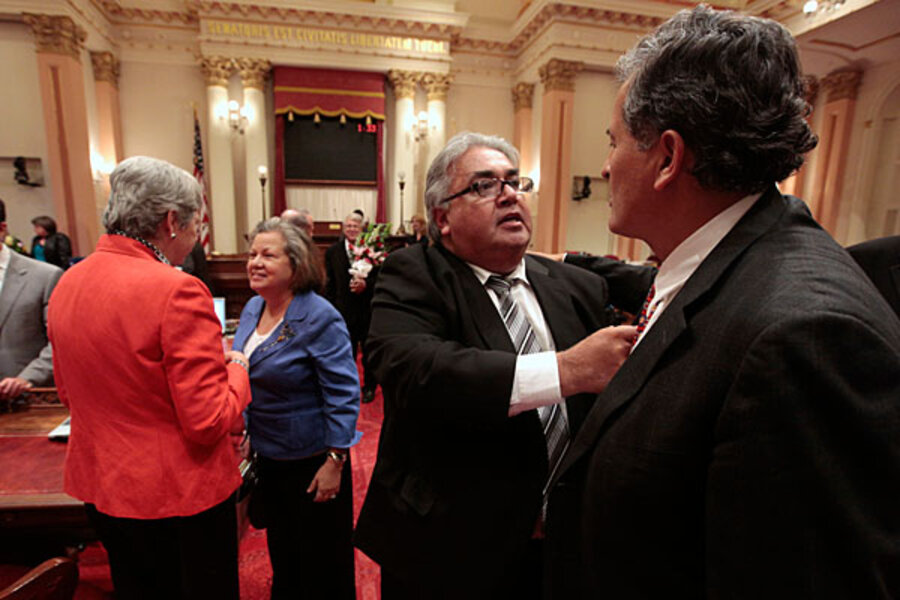California a political model? Golden State has most competitive elections.
Loading...
| Los Angeles
Elections for the California state Legislature are the most competitive in the country this year, according to a new analysis, suggesting that wholesale reforms here are beginning to change a political system known for perpetual gridlock.
Whether those changes will improve California government – and whether they will last – remain to be proven, many experts say. But competitiveness is a key measure of political vibrancy and the report is a positive sign for Golden State politics, they add.
“Competitiveness gives voters a real choice in elections," says Steven Schier, political scientist at Carleton College in Northfield, Minn. "It is an essential element for popular control of government.”
California has fared well in the previous two editions of Ballotpedia's State Legislative Electoral Competitive Index, finishing eighth in 2010, for example. Yet its improvement in one key area of the online almanac's survey – "Do incumbents face a primary challenger?" – has been dramatic. In 2010, 9.7 percent of California incumbents faced a primary challenger. This year, the figure has jumped to 35.7 percent.
(The two other elements of the Ballotpedia ranking deal with whether an incumbent is running and whether there are two major-party contestants in the general election.)
The jump in the competitiveness in primaries for California state legislators can be directly traced to two political reforms passed by ballot initiative in 2010, which are taking effect for the first time this year.
- First, voters took redistricting out of the hands of the legislature and gave it to a nonpartisan commission.
- Second, voters threw out the old primary system and replaced it with a "Top Two" primary, in which any voter can vote for any candidate, and the top two vote-getters – regardless of party – advance to the general election.
Indeed, California’s ideological polarization during the past decade – seen as fundamentally linked to its rising gridlock – was rooted in the redistricting plan of 2002, which maximized incumbent safety and minimized general-election competition, says Lara Brown, author of “Jockeying for the American Presidency.”
In the 2010 initiatives, California voters “did something that is exceedingly difficult: changing the rules that structure the electoral process over the heads of the incumbents who have every interest to retain the status quo," says Professor Brown. "The new redistricting map and the new primary law are now beginning to change the politicians. In the not too distant future, Californians are also likely to see a change in the politics in Sacramento.”
“Primary elections for seats in the US House, state Senate, and state Assembly were either uncompetitive for partisan incumbents, or when there were open seats, they turned into ideological fidelity battles for the challengers,” she adds.
The reason voters should want to see competitive elections is because when an incumbent is able to sail through the primary and general elections, he or she is not being held accountable, says Tyler King, lead researcher for Ballotpedia's survey.
That can be particularly true in places like pre-reform California, where districts are drawn to give one party a clear advantage. In those cases, it is relatively unlikely that the average incumbent will see much of a challenge in the general election. That makes the primaries even more important.
“To put it plainly, a lot of races are decided in the primary election,” says Mr. King.
Competitive primaries also force incumbents, who generally have a much larger war chest, to spend more of that money earlier, making the system fairer, King adds.
King and other analysts say this competitiveness could help break California's partisan gridlock.
“The upshot of all of this is that with a wider set of more competitive races, we should expect to see more median candidates, that is, more moderates and thus, the poles – far right and far left – should come to the middle more,” says David McCuan, a political scientist at Sonoma State University. “And if there is anything that Sacramento needs it is more compromise and harmony and less acrimony.”
Other analysts are less hopeful. Some of the new competitiveness is because redistricting has pitted incumbents against each other in new districts. Next election cycle, that won't be the case.
“The apparent upsurge in competitiveness is largely a one-shot deal, not a fundamental shift in California politics,” says Jack Pitney, a political scientist at Claremont McKenna College.
“We need to see a longer trend line before we start celebrating the revival of competition,” adds John Johannes, a political scientist at Villanova University.
Moreover, by one important measure of "competitiveness" California fails spectacularly, adds Professor Pitney: “In much of California, the Republican Party has essentially gone out of business. Democrats currently control all statewide offices. Within an election or two, they will probably have two-thirds majorities in both chambers of the Legislature. Any measure of 'competitiveness' that overlooks one-party dominance is necessarily incomplete.”
Still, some observers see something promising in this round of elections.
“One of the great dilemmas of all of us wanting to make the system work better is to decide whether you want to make a great big change all at once or a series of small, incremental changes,” says Jim Mayer, executive director of California Forward, a governance-reform project. “We found you can’t change the Legislature overnight, but if you can change the rules about incentives that encourage people to reach across the aisle, you will start to see serious improvement over time.”
He sees a potential turning point with the election of California’s next round of freshman legislators. “In the conversations we’ve had with those in the legislature as well as first-time candidates, we’re seeing the thinking is already different.”







